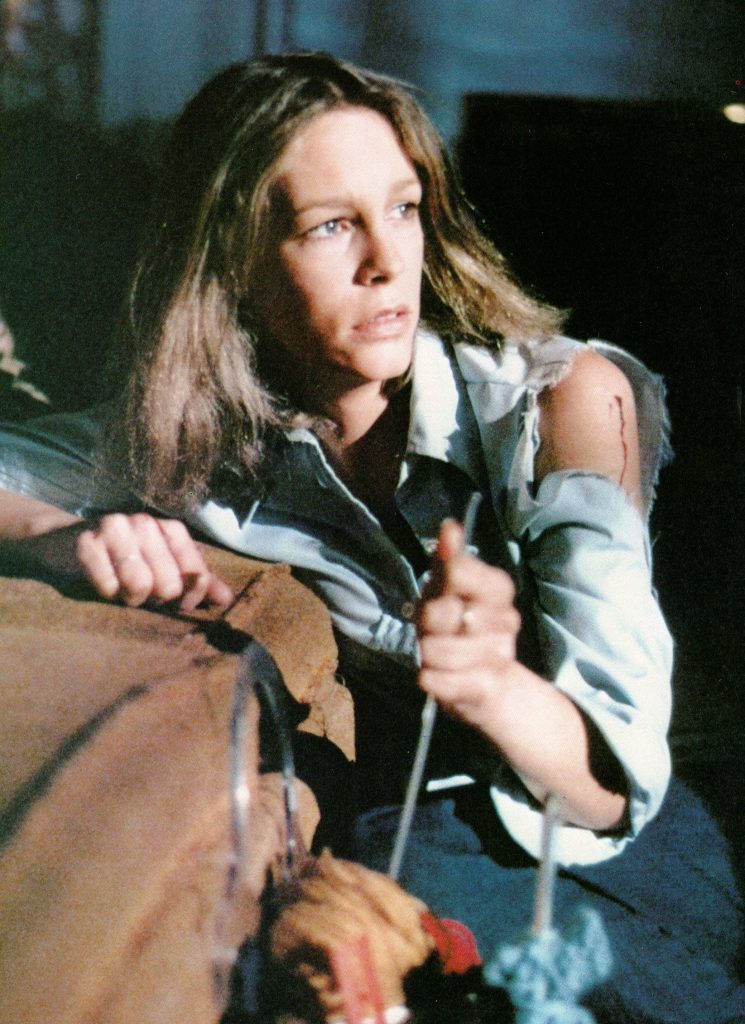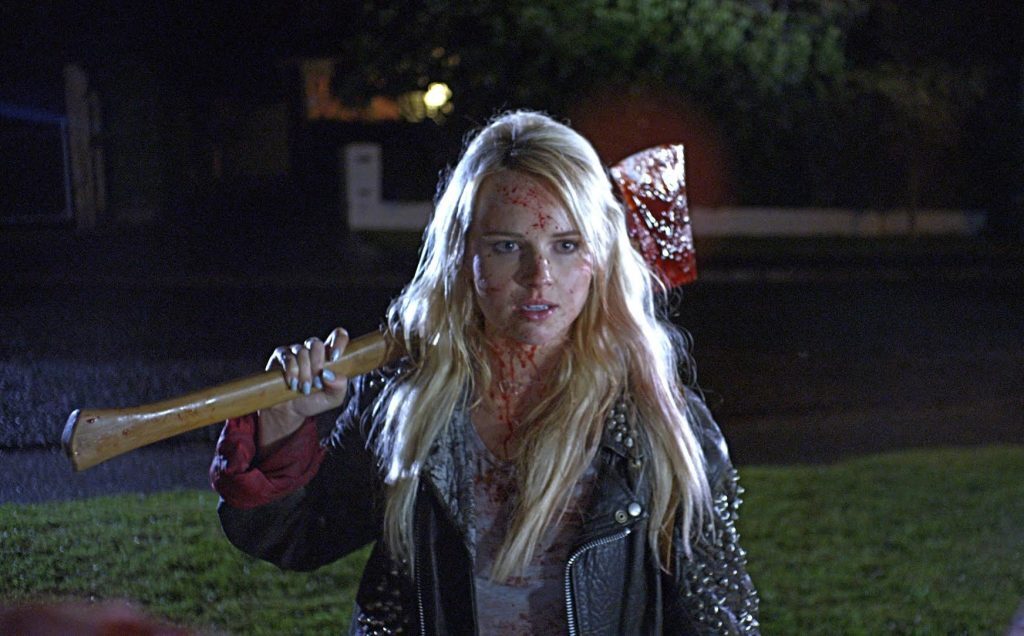
It has been said that “women in peril work better in the suspense genre … If you have a haunted house and you have a woman walking around with a candelabrum, you fear more for her than you would for a husky man.” (Clover; pg. 77) With this statement, we can almost summarize the entirety of the horror genre’s tilt towards what some might call misogyny perpetuated by the film industry’s propensity for being male-dominated. We can also build towards a much more interesting concept—that of the Final Girl.
Throughout the lifespan of horror, we see that a woman in peril is hardly a new trope within the genre—in fact, the evidence of its existence can be seen clearly in literature such as that of Edgar Allan Poe, where he regularly relied upon the formula to create suspense within his works. His perspective, however, that “the death of a beautiful woman is the ‘most poetical topic in the world,’ does little to help us in understanding where this pattern comes from. We know the Final Girl is rarely, if ever, regarded for her evolution from victim to heroine, but what is less clear is why that is such a rarity.
The Villain: Epitomizing the Slasher
The killer is with few exceptions recognizably human and distinctly male; his fury is unmistakably sexual in both roots and expression; his victims are mostly women, often sexually free and always young and beautiful ones. Just how essential this victim is to horror is suggested by her historical durability.
Carol J. Clover, pg. 77 – Her body, himself: Gender in the slasher film
The argument goes that men are victims but Clover argues that, “… if some victims are men … most are women, and the women are brutalized in ways that come too close to real life for comfort…” (pg. 77). It’s true too, that the genders are each represented in their reflections on the screen and this encourages the impulse to identify the impulse of committing sexual violence with men as well as the victimization in their female counterparts. While that association isn’t necessarily flattering to the emboldened female of the modern age, it’s been a trope for such a long time that it’s hard to deny its root in historical facts. Cross-gender identification can and has been entertained as a possibility, but only in the sense that the females watching can identify more closely with the male roles.
The Male Role in Horror: The Killer or the Failed Hero
These days, more often than not, the male viewer can only identify with two portrayals of himself—the killer or the failed hero—male parts are more marginalized, with few exceptions, their characters tend to be more underdeveloped and without fail they have a tendency to die early within the film. We see males portrayed as “policemen, fathers, and sheriffs,” who, if they don’t end up as a victim, only have enough screen time, “to demonstrate risible incompetence,” and if they’re not portrayed in this manner, they’re being portrayed as the killer.
The killer, the villain, the slasher, the butcher—he’s the one that competes with the first victim for the least amount of screen time. We barely see him during the first half of the film, but when we do finally see him as more than a silhouette or a brief flash across the camera we see a character that is hard to identify with.
Who is the Final Girl?

Horror movies, especially slashers, have a tendency to boast large body counts—after all, excess is the name of the game—and as we’ve learned those bodies are usually females and pretty ones to boot. One thing that we also have a tendency to see within these same movies, is that the one character who does live to tell the tale, that is to say, if anyone is alive by the end, is fated to be female. This is the famous Final Girl that, we can reliably pick out of the crowd of horny teenagers based on her advanced character development.
Once picked out of the crowd, we see that her storyline is really the only one that has any attention paid to it—outside of the killer’s that is—unlike the rest of the female characters, she has been bestowed a more reasonable set of characteristics. If she’s not operating on pure luck, she likely impresses us with her intelligent watchful eye and her ability to stay more level-headed when she’s put under pressure. She’s typically the first one to notice anything is wrong, but this is generally chalked up to a “gut feeling” which shows us that her instincts are significantly greater than the characters that are more disposable. She is the only character whose view, or perspective, of the situation most closely matches our own as the audience.
We register her horror as she stumbles on the corpses of her friends; her paralysis in the face of death duplicates those moments of the universal nightmare experience on which horror frankly trades. When she downs the killer, we are triumphant. She is by any measure the slasher film’s hero. This is not to say that our attachment to her is exclusive and unremitting, only that it adds up, and that in the closing sequence it is very close to absolute.
Carol J. Clover, pg. 79 – Her body, himself: Gender in the slasher film
Women in Peril
While women in peril can be found in almost any genre—the damsel in distress is a popular motivation for any male antagonist. However, as Clover points out in her essay on gender within the slasher film, women in peril tend to work better within a genre of suspense. This stems from origins in such serial productions as The Perils of Pauline (1914); the consensus is that if we were to see a male and female wandering around a haunted house (or other precarious situation), we would invariably be more worried for the female than for the male. This perspective is all too accurate, despite the rise in female heroines in action movies and thrillers and has more to do with how much we can identify with gender and less to do with misogynistic perspectives.
Perhaps it’s the range of emotional expression that the genders are each allotted within these storylines, where the men are given the macho aggression or displays of force, women are given the displays of “crying, cowering, screaming, fainting, trembling, [and] begging for mercy.” In essence, the feminine reaction to violence, killing, or simply-put terrifying situations, is “abject terror”.
The Evolution of Perspective
We see within the beginning of these types of films that we have a more intimate view of the killer’s perspective; a perfect example of this would be the opening scene of Halloween (1978) where we are literally seeing through the eyes of a six-year-old Michael Myers as he watches his sister, who instead of babysitting him as she was supposed to, is getting it on with her boyfriend. We see him intentionally sneak through the house while his sister and her boyfriend are aggressively cuddling upstairs, and watch as he grabs the biggest sharpest knife available to him. While we don’t want to identify with this perspective, even though we are forced to see through this lens, we do experience the waxing anxiety that comes with him padding up the staircase and stabbing his breast-baring sister to death. To be quite frank though, it’s not necessarily the perspective that is really disturbing, it’s the moments where we hear the killer’s breathing or heartbeat.
This forced perspective links us, albeit unwillingly, with the killer during the earliest parts of the film, we know him before we know any other character of importance to the storyline. We know his perspective before we even know what he looks like, or in most cases, who he is and what his story might be. We know him before we know our Final Girl—this is done intentionally. Although in Final Girl (2015) we see the pattern flipped, so we see and know who the Final Girl is before we know who the bad guys are (and oddly almost want to identify with them right before they are taken out by our heroine). Aside from the minor outliers to this pattern, the progression of the film leads our shift of perspectives from the killer to the Final Girl. As Clover cleverly stated, “our closeness to him wanes as our closeness to the Final Girl waxes—a shift underwritten by storyline as well as camera position.”
By the end, point of view is hers: we are in the closet with her, watching with her eyes the knife blade stab through the door; in the room with her as the killer breaks through the window and grabs at her; in the car with her as the killer stabs through the convertible top, and so on. With her, we become if not the killer of the killer then the agent of his expulsion from the narrative vision. If, during the film’s course, we shifted our sympathies back and forth, and dealt them out to other characters along the way, we belong in the end to the Final Girl; there is no alternative.
Carol J. Clover, pg. 79 – Her body, himself: Gender in the slasher film
Final Thoughts on the Final Girl
Ultimately when it comes to the Final Girl, I don’t see mysogynistic screenplays, instead I see simple tropes in horror that were stumbled upon by writers who ultimately understood the value of a character that everyone could root for. It’s a human condition to thrive off of excess, this is true for, “sex, violence, and emotion [as they] are fundamental elements of the sensation effects of [pornography, horror, and melodrama],”—we grasp for the gratuitously violent, the gratuitously sexual, and the gratuitously depressing because of the effect they have on our bodies (Williams; pg. 3).
If we were to try to label the reason for the existence of these “heavy doses of sex, violence, and emotion,” we would have to face the fact that they are there for no other reason except to excite us into reacting. Therefore, when we see this Final Girl and her implicit androgyny, her assumed virginal state, her intelligence, and her eagle-eye for understanding the situation that is unfolding before her and we say, “Yep! That would be me if I were in that situation!” We think to ourselves that we would never be the first one to die, we would run out of the house instead of cornering ourselves upstairs, we would never look back while we were running and would therefore never trip over our own feet—and we would never ever utter the phrase, “I’ll be right back.”
Work Cited
Crow, David, et al. “The 13 Best Final Girls in Horror Movie History.” Den of Geek, 30 Sept. 2020.
Kendrick, James. “Slasher Films and Gore in the 1980s.” A Companion to the Horror Film, by Harry M. Benshoff, Wiley Blackwell, Chichester, West Sussex, 2017.
Lentini, Lori. “5 Horror Movies Where Females Took a Big Bite Out of the Bad Guy.” Puzzle Box Horror, 27 Apr. 2020.
Williams, Linda. “Film Bodies: Gender, Genre, and Excess.” Film Quarterly, vol. 44, no. 4, 1991, pp. 2–13.

Georgia-based author and artist, Mary has been a horror aficionado since the mid-2000s. Originally a hobby artist and writer, she found her niche in the horror industry in late 2019 and hasn’t looked back since. Mary’s evolution into a horror expert allowed her to express herself truly for the first time in her life. Now, she prides herself on indulging in the stuff of nightmares.
Mary also moonlights as a content creator across multiple social media platforms—breaking down horror tropes on YouTube, as well as playing horror games and broadcasting live digital art sessions on Twitch.
